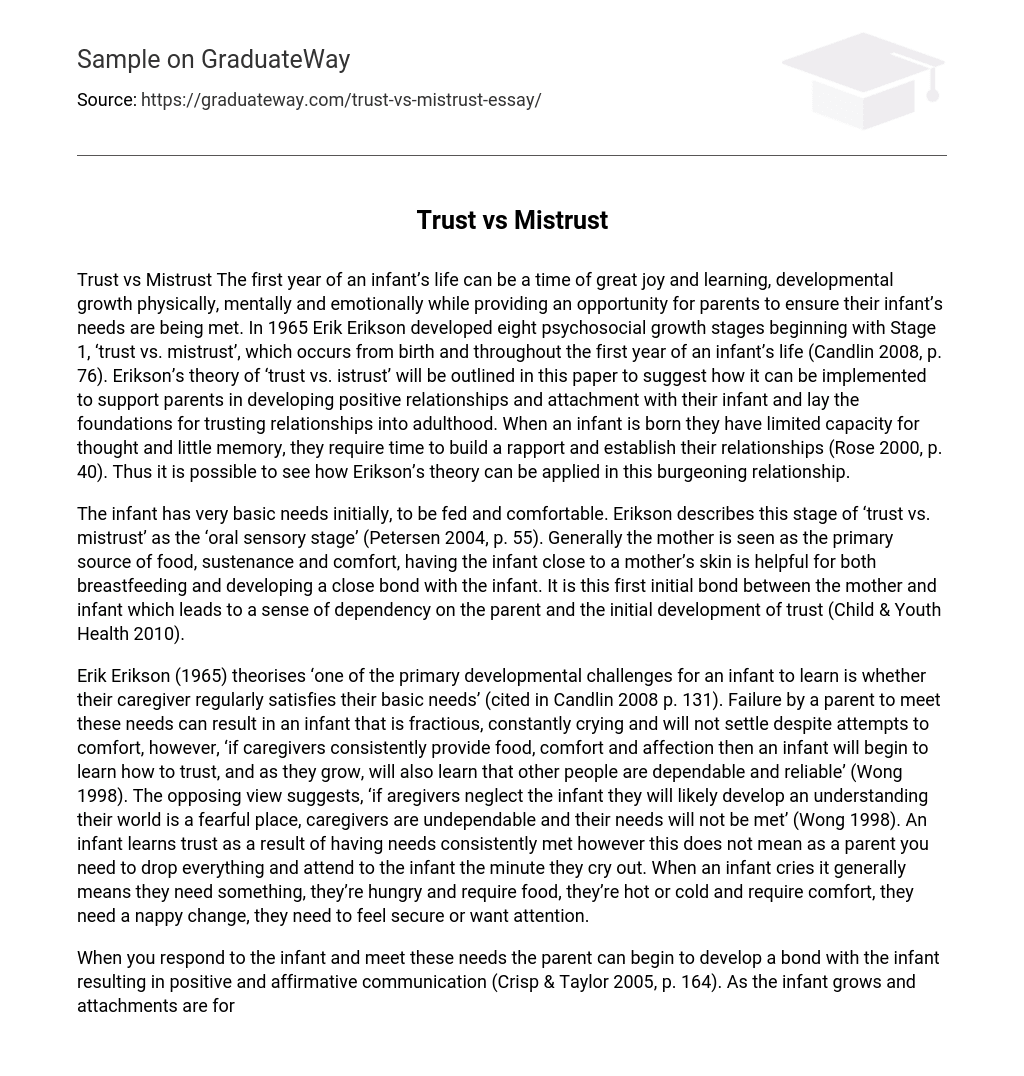Throughout the initial year of a baby’s life, parents have numerous chances to meet their child’s needs and witness development in various aspects – physical, mental, and emotional. This phase is also regarded as a period of great joy and education. In 1965, Erik Erikson introduced eight stages of psychosocial development, with Stage 1 labeled as ‘trust vs. mistrust’. This stage encompasses the entirety of the first year since birth (Candlin 2008, p. 76).
Erikson’s theory of ‘trust vs. mistrust’ will be discussed in this paper to propose its application in assisting parents in fostering positive relationships and attachment with their infant. This, in turn, forms the basis for cultivating trusting relationships throughout adulthood. As cited by Rose (2000, p. 40), when infants are born, their cognitive abilities and memory are limited. Consequently, they necessitate time to establish rapport and develop their relationships. Therefore, Erikson’s theory can be aptly applied in this nascent bond.
During the early stage of a baby’s life, their main needs are to be nourished and comfortable. This phase is referred to as the ‘trust vs. mistrust’ or ‘oral sensory’ stage by Erikson (Petersen 2004, p. 55). The mother plays a crucial role as the primary provider of food, sustenance, and comfort. Keeping the baby close to the mother’s skin has multiple benefits, including facilitating breastfeeding and establishing a strong bond with the child. This initial connection between mother and baby is essential for fostering reliance on the parent and developing trust (Child & Youth Health 2010).
According to Erik Erikson (1965) cited in Candlin 2008 p. 131, infants must determine if their caregiver consistently meets their basic needs for development. If these needs are not met by a parent, the infant may exhibit fussiness, continuous crying, and resistance to calming down despite attempts to provide comfort. Conversely, consistent provision of nourishment, reassurance, and affection by caregivers will result in the infant learning to trust. As they grow, they will also develop an understanding that others can be relied upon and trusted (Wong 1998).
The opposing perspective contends that when caregivers fail to care for the infant, the infant will view their surroundings as alarming and believe that they cannot rely on their caregivers to fulfill their needs (Wong 1998). The establishment of trust in infants happens when their needs are reliably satisfied. Nevertheless, this does not mean that parents must promptly address every cry from the infant. Crying frequently indicates that the infant needs something like nourishment when hungry, warmth or coolness when excessively hot or cold, a change of diaper, a feeling of safety, or attention.
When the needs of the infant are met and responded to, a bond is formed between parent and infant. This bond leads to positive and affirmative communication (Crisp & Taylor 2005, p. 164). As the infant grows and develops attachments, they also perceive their primary caregivers as sources of safety (Honig 2002, p. 22). Once infants reach the crawling stage, they begin exploring their environment including other individuals, nearby objects, and things.
If infants feel safe and secure, they will start exploring their surroundings and attempting to stand. This is because they have the assurance that their parent or caregiver is accessible and nearby for assistance if necessary (Honig 2002, p. 22). The consistent presence of their caregiver since birth has created a feeling of familiarity and trust, allowing them to freely explore and play without feeling any sense of danger (Honig 2002, p. 22).
According to Candlin (2008, p. 64), Erikson’s developmental stage of ‘trust vs. mistrust’ can be understood by parents as their infant starts to explore and gain a sense of independence. If a baby has a reliable and caring caregiver, they will feel safe and confident to explore on their own without feeling fearful or distrusting (Honig 2002, p. 22).
References
- Candlin, S 2008, chapter 4 ‘Relinquishing independence: A new beginning’ in Therapeutic Communication, a lifespan approach, 1st edn, Pearson Education, Australia, Frenchs Forest, NSW, pp. 70-95.
- Candlin, S 2008, chapter 6 ‘Infants and Young Children: coping with change’ in Therapeutic Communication, a lifespan approach, 1st edn, Pearson Education, Australia, Frenchs Forest, NSW, pp. 116-137.
- Child and Youth Health 2010, viewed 25 April 2010, Crisp, J & Taylor, C (eds) 2005, chapter 10 ‘Developmental theories’ in Potter & Perry’s fundamentals of nursing, 2nd edn, Elsevier Australia, Marrickville, NSW, pp. 158-174.
- Erikson, EH 1965, Childhood and society, 2nd edn, Norton, New York, NY HelpGuide. org 2001-2010, Bonding with your baby, viewed 18 April 2010,





